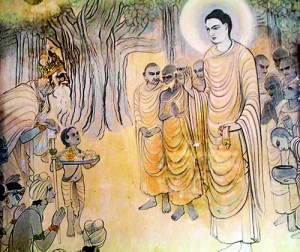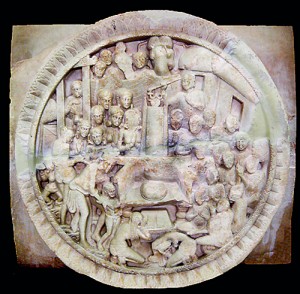Medin Poya: Lord Buddha visits his birthplace after 7 years
The earliest sculptures of the Life of the Buddha displayed in some foreign museums depict scenes of the Buddha’s first visit to the city of his birth – Kimbulwathpura (Kapilavasthupura) – an event which signifies Medin Poya which falls today. Several landmark events took place during his visit, which he made seven years after he left the Royal Palace.
According to some of the ancient sculptures Professor Osmund Bopearachchi (Director of Research of the French National Centre for Scientific Research (CNRS), Paris and Professor of Central Asian and Indian Archaeology and Numismatics at Sorbonne University

The paintings at Mula Ghandakuty Viharaya
among many other designations) had come across in foreign museums, the most popular subject from the Buddha’s visit that had touched a chord in ancient artists was that of Princess Yasodhara sending her 6-7 year old son Rahula to the Buddha, to ask for his inheritance.
Professor Bopearachchi, had been documenting ancient art depicting the life of the Buddha from museums round the globe.
Some of these sculptures, particularly the ones depicted on the four toranas of the Great Sanchi Stûpa and on the balustrades of the Bharhut Stûpa, date back to the second and first centuries BCE when artists still regarded Buddha too sacred to be sculptured. However, the Andhra School of art at Amaravati that the art historians date to the second or the third centuries of our era, is characterised by anthropologic images of the Lord Buddha as well as by symbols such as the Bodhi tree, triratna, trone and Buddhapada. As such,in the stone sculpture (see pictures) – an exhibit at Amaravati Museum (in Andra Pradesh) and of Amaravati School of Art, Yasodhara is seen pushing her son towards the Buddha, whose image is represented through symbols. A seat symbolises the Buddha and at the head of the seat is the symbol of the Three Rathna – The Buddha, the Dhamma and the Sangha. The Buddha’s footprints are at the foot of the seat.
Apart from Yasodhara and her son are devotees bending low and worshipping the Buddha. Bhikkhus are among the crowd. The background is a park. There are heads of a horse and an elephant, sculptured at the top as watching this scenario that took place in Kimbulwathpura.
![Medin Poy- Rahula - Mula Ghandakuty Viharaya[1]](http://www.sundaytimes.lk/140316/uploads/Medin-Poy-Rahula-Mula-Ghandakuty-Viharaya1-300x231.jpg)
The paintings at Mula Ghandakuty Viharaya
In a sculpture now exhibited in the British Museum also of the Amaravathi School of Art, Yasodhara is seen pushing Rahula towards the Buddha with both hands, The Buddha’s Image in this work of art is prominently carved. Therefore, this sculpture is a good example to show how the Buddha was depicted in human form.
However, Princess Yasodhara and her son Rahula’s episode had been the most featured in early Buddhist sculptures. Amaravathi sculptures usually are crowded and over decorative and according to Professor Bopearachchi, these had been carved on slabs of a kind of hard lime stone (marble) found in Nagarjunakonda in Andhra Pradesh.
Even the more recent Japanese-styled mural paintings on the walls of the Mulgandha Kuti Vihara at Sarnath by the Japanese painter, Kosetsu Nosu, depict little Rahula, walking towards the colossal figure of the Buddha with a tray of flowers, asking for his inheritance and the next mural has the Royal family with Rahula on the lap of Yasodhara, listening to the Buddha in the Royal Palace.
Professor Sucharitha Gamlath, Professor of History (now deceased) who quotes from ancient Commentaries in his “Buddha Charithaya” (Portrayal of the Buddha) has written that the Buddha attained Buddhahood in 528BCE. If the Buddha made his visit to Kimbulwathpura seven years later, then the event that signifies Medin Poya took place in the year 521BCE.
According to “Buddha Charithaya,” when King Suddhodhana learnt that the Buddha had arrived in Rajagahanuwara, he sent a minister with thousand people to invite the Buddha to Kimbulwathpura (Kapilavasthupura.) The party reached the destination at a time when the Buddha was delivering a sermon. They listened to the dhamma and attained Arahathood. And the Buddha, admitted them to the Sangha Sasana.
King Suddhodhana, who was anxiously looking forward to seeing his son, sent similar groups nine times with the result being the same.

The stone sculpture at the Amaravati museum in Andhra Pradesh
It was then that the King approached Kaala-udaai – a playmate of the Buddha in his younger days. Kaala-udaai agreed to go on the basis that he be allowed to take to robes once he completed his mission. This was agreed upon but it being winter season in North India, he probably delayed his visit till the arrival of spring. And in March in the month of Medin, Kaala-Udaai visited Rajagahanuwara.
The Buddha accepted the invitation and along with 20,000 monks, walked to Negrodharama – a garden of Nuga trees which Dr. Bopearachchi says was 6 kilometres away from Kimbulwathnuwara. On hearing of his arrival, the Shakya clan accompanied the King to the Park. But, except the younger Shakyans, the rest remained standing when the Buddha, realising the arrogance of the Shakyans, sprang to the air and performed the twinfold miracle “yamamahapelahera.” The King marvelled and worshipped the Buddha for the third time. The rest of the clan then followed suit.
The following day, with no invitation extended for alms, the Buddha and the monks, went begging for alms on the road when Yasodhara, shocked and trembling on seeing this, informed the king of it. The king, rushing up to the Buddha declared that the Kshatriyas descended from the Great Heavenly King and asked him to refrain from insulting his clan. The Buddha’s famous reply was then made :“Mine is the Buddha clan that comes down from Deepankara, Kakruchandra, Vipasya, Kanakamuni to Kasyapa…..and thousands of Buddhas lived by begging on the road. Yours is the royal lineage.” And the Buddha spoke of the essence of his teachings. The King by listening to His words, attained the Path of Sovan. He thereafter, took the Buddha’s begging bowl and invited the Buddha and the monks to the palace for alms.
Following the partaking of the alms, according to “Buddha Charithaya,” everybody in the Royal Palace listened to the Buddha when King Suddhodhana attained the next step – the Path to Sakkrudagami – which leads to be born once before attaining Nirvana. He also attained the Path to Anagami during this same visit which meant that he would attain Nirvana without being born again.
Yasodhara was conspicuously absent at this gathering and when she was urged to come out, she said “He will come to me if I have not committed any wrong. I will worship him then.”
The Buddha, handing over his begging bowl to the King, walked into Yasodhara’s inner chamber and took the seat that was prepared for him. Yasodhara, according to records, crawled to the Buddha, held both His ankles and taking them round and round her head worshipped Him to her heart’s content. The king, later addressed the Buddha and said “Sir, when this my daughter, heard you wore yellow robes, she too wore them. When she heard you have only one meal a day, she too did the same. When she heard you had done away with luxury beds, she started sleeping in a narrow bed. And she stopped wearing garlands and using perfumes and anointing scents on her body.” In reply, the Buddha said “Yasodhara remained faithful to me even in her previous births.” And He related the “Sandakinduru Jatakaya.”
“Buddha Charithaya” mentions that some of the ancient literature which wrote about her fidelity stated that she refused undesirable proposals made by Devadatta and Sundarananda.
On the seventh day when Rahula who followed the Buddha to Negrodharama Park asking for his wealth “Buddha Charithaya” says thus: The Buddha thought,” the kind of wealth he is asking for may harm him. I will give the Dhamma which I learnt at the foot of the Bodhiya which is the most noble wealth that goes beyond worldly values.”
And Buddha requested Sariyuth Thera to ordain Rahula which drove King Suddhodhana in desperation to request the Buddha to refrain from ordaining children without the knowledge of the parents. Buddha included this in the Buddhist ethics.
However, the outcome of utmost significance of the Buddha’s visit to Kimbulwathpura was the ordaining of His step brother Nanda as Ananda Thera. Nanda was to be the next ruler of Kimbulwathpura and was preparing for his coronation as well as for his marriage. The Buddha however, asked Nanda whether he wished to take leave of domestic life. Nanda in respect for the Buddha said he was and the Buddha asked the monks to ordain him. Ananda Thera was appointed as Dharmabandagarika. He served as Buddha’s personal attendant and his services to the Sasana cannot be estimated.



